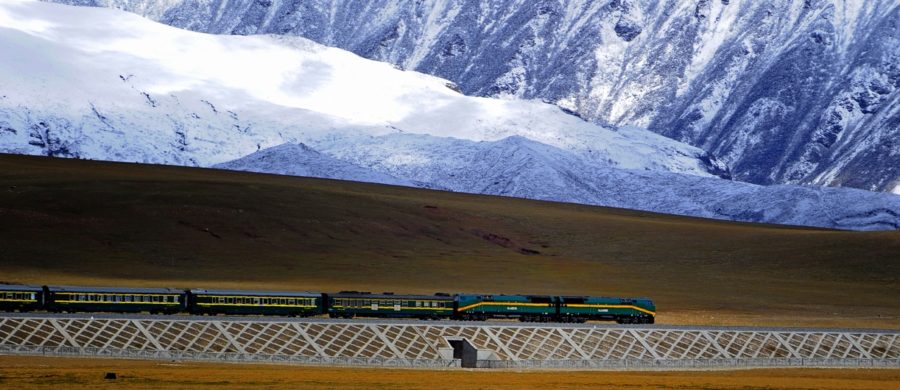
Riding the Permafrost Rooster Across the Roof of the World
Technology’s Stories v. 2, no. 3 – doi: 10.15763/JOU.TS.2014.10.1.01
PDF: Canavan_Permafrost Rooster
Background
“Iron rooster” is a Chinese phrase for a stingy bird, one so difficult to pluck it might as well be made out of iron. Paul Theroux borrows this phrase in Riding the Iron Rooster to describe his arduous train travels across China during the 1980s.[1] The Tibet Autonomous Region has long retained an exotic allure for travelers crossing to China’s western region. However, this mountainous region, a natural and political buffer between China and India, had been impossible to reach by rail.
Today, travelers no longer have to possess the grit and resolve of adventurous backpackers to get to Tibet. Beginning in 2006, rail passengers could cross the vast permafrost environment of the Qinghai-Tibet Plateau (known as the Roof of the World) from Golmud into Lhasa via the longest high-elevation railway in the world (Figure 1). The Qinghai-Tibet Railway (QTR) has firmly established China’s technological prowess and has provided a strategic connection to the plateau for natural resources as well as for geopolitical advantages. Some argue that the railway will expedite the transfer of population that will make Tibetans a minority group in their own land.[2]
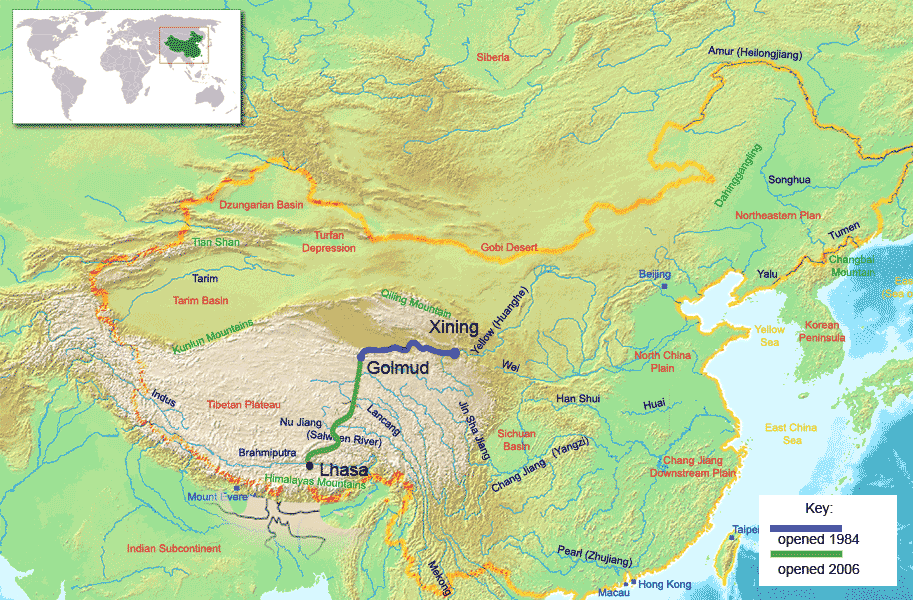
Qinghai Railway Map, 2006. (CC BY-SA 3.0)
The Beijing-Lhasa rail journey covers a distance of 3,753 kilometers through seven Chinese provinces. For nearly 1,000 kilometers, the QTR runs at an altitude over 4,000 meters above sea level.[3] Across a windswept landscape, the QTR provides passenger carriages with enriched-oxygen systems, UV-protection and sleeper cars, powered by diesel engines that traverse the frozen ground at speeds of up to 100 kilometers per hour. Most medical advisors recommend five full days to climb to the highest altitudes, yet the train takes only 36 hours to make the steepest ascent. To compensate, every berth and seat on the train has access to 40% oxygen delivered though a narrow tube into the nose (for those who need it). As the QTR ascends to its maximum altitude over the Kunlun Range of 5,072 meters, ink pens leak and vacuum-sealed food packages explode.
This essay focuses on the technological challenges of building the “permafrost rooster”, the scientific insights derived from its construction, and the unintended consequences of a daring infrastructure project across such a remote frozen landscape. The QTR not only transports about 900 passengers from Beijing to Lhasa within a few days, but also provides a lens into remarkable science undertaken at the intersection of diverse disciplines: cold regions science, high altitude medicine, climate science, wildlife biology, virology, remote sensing technology, bioscience, and global health.
The first section of this essay reviews the environmental challenges and technical solutions of building a railroad into Tibet. High Altitude Medicine examines the QTR construction in the context of human adaptation to high altitude. Opening Pandora’s Box at the Roof of the World examines how the QTR and related events on the plateau led to new questions about the ecology of influenza at the human-animal interface, an account that is relevant for global health. Broader Impacts challenge the reader to consider how the Qinghai case illuminates the cumulative effects of our most pressing environmental and global health dilemmas.
Technology, Culture, and the Environment: Building a Railway on Permafrost
The potential for a railway across the Roof of the World provided a powerful incentive for the Chinese to study permafrost regions of the Qinghai-Tibet Plateau beginning in the 1950s. The government planned and ran scientific studies but had to wait for technology to tunnel through ice and lay track on permafrost for the creation of the QTR.[4] By 2001, ambitions of the late fifties had the backing of science, funding, and political will. At a cost of $4.3 billion, it has been an audacious project. China is counting on the rail to reduce the cost of transport to Tibet by fifty percent, speed economic development, and stimulate business by bringing tourists into Tibet by train each year.[5] By the end of the first year of operation (2006), 2.5 million tourists had visited Tibet, half of whom arrived via the QTR.[6]
The QTR crosses terrain that illustrates China’s environmental challenges outside the industrial pollution of its populous cities. In western China, dry high plateaus give way to large permafrost regions and impassable mountain ranges as elevation increases. The high plateaus possess fragile grassland ecosystems. Home to ethnic Tibetan herders, the lower elevations of the plateau were legendary for grasses that reached “high as a horse’s belly.”[7] When discovered by travelers in the Middle Ages, the “dazzling horns of rare antelopes prompted tales of unicorns.”[8]
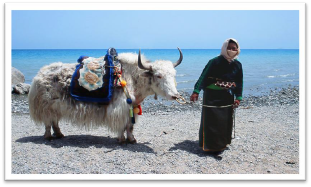
Woman with yak at Qinghai Lake. Photo credit: Bengchye Loo, 2007. (CC BY 2.0)
Today, people, yaks, and sheep contribute to erosion and grassland degradation following decades of warming temperatures and overgrazing (Figure 2). Grassland degradation is now so extensive that rats have invaded the fragile wetlands and have chewed through one third of the lower elevation grasslands.[9] In 2009, Qinghai’s government launched a 10-year plan to restore Qinghai Lake and the surrounding grasslands. The project includes the construction of small towns in which nomadic herders and their livestock would settle.[10] Grassland relocation programs for herders have been, in some cases, involuntary.[11]
The engineering challenges at the highest altitude region of the Qinghai-Tibet Plateau are even more profound. Drawing on three decades of study, the Chinese Academy of Sciences reports that the instability of the permafrost on the Qinghai-Tibet Plateau causes grave geological problems beneath major roads and rails. Permafrost is perennially frozen earth, with a temperature below 0° C continuously for two years or more. The permafrost deep in the ground is not the critical problem. The dilemma is that the active layer on top freezes in winter and thaws in summer, causing the ground to become more like a bog or swamp. This active layer of permafrost slumps when it thaws, causing the soil to collapse, and anything constructed on top of it to shift. The signals of climate warming on the plateau are intense.
Climate scientists report the high altitude region of the Qinghai-Tibet Plateau is warming faster than anywhere on earth outside the poles.[12] The plateau experiences intense solar radiation due to both its low latitude and its high altitude.[13] Data from over ninety temperature stations show that the Qinghai-Tibet Plateau has experienced “statistically significant warming” since the mid-1950s, exceeding rates for the northern hemisphere at the same latitude.[14] Why are temperatures on the Qinghai-Tibet Plateau rising faster than expected? Evidence from scientific studies suggests that rapid increases in black soot deposits from neighboring regions are a contributing factor, particularly since the 1990s. Black carbon soot is the result of incomplete combustion from cooking on fires that burn dried dung, wood, brush, and crop residues creating a darkening, warming effect on land surfaces.[15]
The United Nation’s Intergovernmental Panel on Climate Change (IPCC) reports that a retreat of permafrost with rising global temperatures is virtually certain.[16] One-third to one-half of the permafrost on the Qinghai–Tibet Plateau will degrade by 2100.[17] Engineers utilized climate change models prior to building the QTR but some early models were overly optimistic. Experiments revealed that this ice-rich soil is sensitive to both load-induced and temperature-induced melting, threatening the railway as it crosses permafrost regions.[18] Inconsistent geophysical cycles have left regions of the plateau frozen in places and melting in others. The railway can cope with a three-degree rise in temperature over time but the steady rise in temperature over decades may well accumulate beyond this limit.
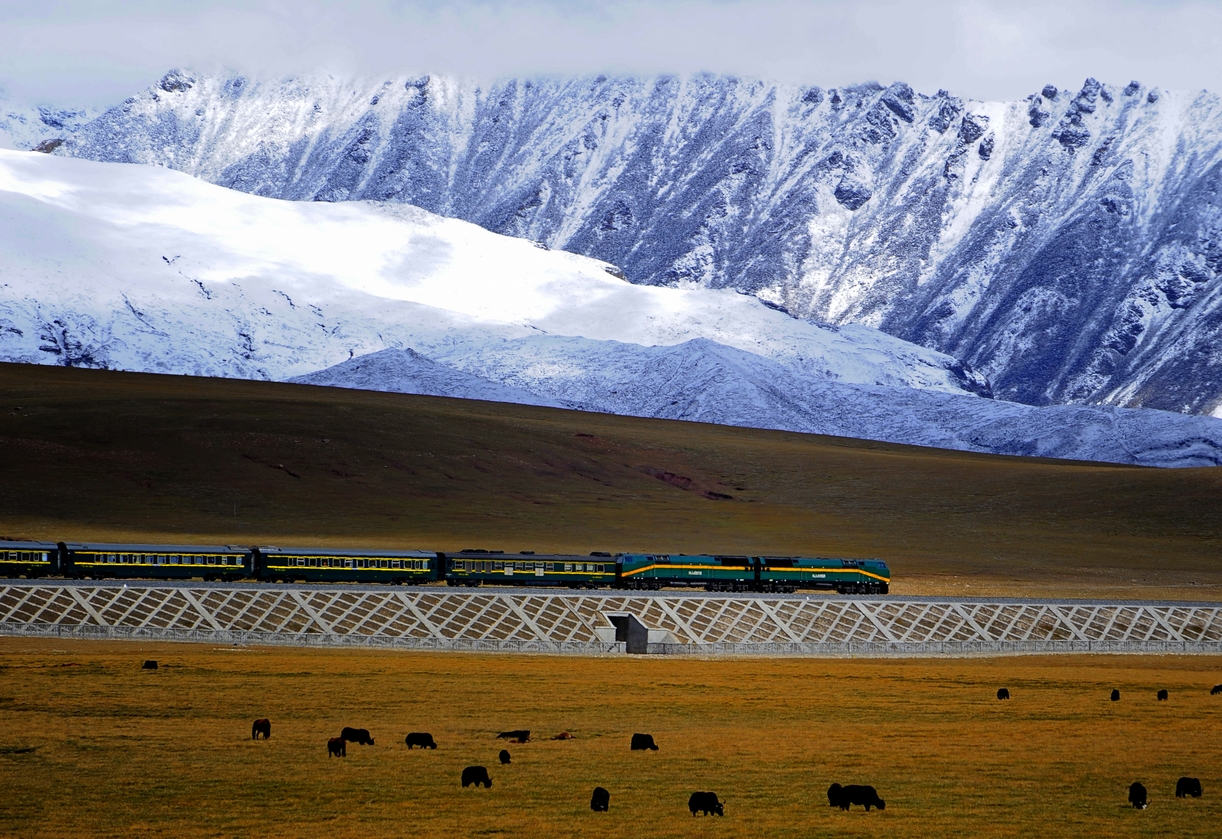
Photo credit: Jan Reurink, 2008. A train pulled by locomotive travels on the Qingzang railway in 2008. (CC BY 2.0).
In response to these challenges, Chinese engineers deployed state-of the-art technology to cool and stabilize the soil layers under the railroad embankment (Figure 3).[19] The goal was to maintain the frozen state of the land under the railway. Experiments that began as early as the 1970s placed large concrete tubes beneath test railway embankments to allow air flow. The embankments stayed frozen. Beginning in 2001, thousands of workers converged at the plateau to use local materials to build rocky embankments. However, in warmer permafrost regions, the crushed rock did not produce enough cooling.[20] Other solutions included shading boards, ventilation ducts, and thermsyphons. The latter are cooling sticks that look like stovepipes jutting out of the ground. They are about 10 meters deep and 20 centimeters in diameter with 9 liters of ammonia in the bottom layer.[21] The ammonia boils at low temperature, drawing heat from the surrounding earth; 34 kilometers of the QTR track are cooled this way.
However, even thermsyphons are not enough in the most fragile areas of warmer permafrost. The solution was to treat these warmer sections as waterways and elevate the rail with bridges secured to deeper permafrost. Yet, the concrete piers heated the soil around the bases when first poured, enough to cause concerns about stability. The answer was to pour the concrete in the dead of winter. Elevated bridges across the slumping soil look like “…a Disney monorail running across the surface of the moon” [22] (Figure 4). Tens of thousands of workers converged at the project’s highest altitudes in these winter periods to build over 165 kilometers of elevated sections for the QTR. New challenges then followed such an influx of workers to this remote, high altitude region.
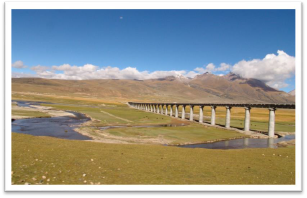
Qinghai-Tibet Railroad. Photo credit: T.CSH, 2008. P. 7
(CC BY-NC-ND 2.0)
High Altitude Medicine
In 1959 when Chinese engineers built the Old Tibetan Highway, over three thousand workers died of exposure and altitude sickness.[23] With this history in mind, the Chinese Ministry of Railroads created a plan to build the QTR extension into Tibet that considered the health risks workers would face.[24] As part of the QTR construction from 2001 to 2006, researchers screened thousands of workers who traveled from lowland habitat to altitudes up to 5,100 meters to work at the construction site. Although workers experienced a gradual ascent to the peak mountainous regions, incidence of altitude sickness upon first-time exposure was 51%.[25] Work on the railroad was limited to the young and healthy and individuals who did not show symptoms of altitude sickness. However, one might consider bias in such a study as the workers may conceal moderate discomfort from altitude sickness in order to stay on the job. Medical specialists became part of the QTR construction project with infirmaries built beside the railway at every eighteen kilometers.
Outside of the QTR project, experts in high altitude medicine have expanded genomic studies in order to study human adaptation. Tibetans have lived at very high altitudes for thousands of years, and they have a distinctive set of physiological traits that enable them to tolerate lower oxygen levels. In fact, current research indicates that Tibetans breathe air that has forty percent less oxygen than is available at sea level, yet they suffer very little mountain sickness.[26] Comparing the genomes of Tibetans and Han Chinese, biologists found at least thirty genes that were rare among the Han but common among the Tibetans. Such differences suggest that the genetic variant typical among Tibetans is the result of natural selection.[27] Researchers also compared oxygen delivery systems between Tibetan and Andean high-altitude natives. At 4,000 meters in altitude, the response to low atmospheric oxygen pressure for Tibetans was about double that of the Andean high-altitude natives.[28] Tibetan women with “genotypes for high oxygen saturation of hemoglobin …have higher offspring survival.”[29] The differences in infant mortality observed between migrant and native high-altitude Tibetan populations support the conclusion that protected fetal growth at high-altitude is the result of genetic adaptation.[30]
Despite this growing knowledge, critics argue that the promised economic development benefits not Tibetans, but Han Chinese, many of whom converged on the plateau to work on the QTR linking Lhasa to the rest of China.[31] In many cases, financial advantages accrue to Chinese corporations that are outside of Tibet and to Chinese-owned businesses.[32]
Global Health: Opening Pandora’s Box at The Roof of the World
As thousands take advantage of the Qinghai-Tibet Railway for the journey to Lhasa, travelers stop at scenic spots along the rail line including the nature reserve at Qinghai Lake, the largest inland saltwater lake in China. The lake appears as a blue mirror between snowy mountains located above 3,600 meters in elevation and surrounded by regions of grasslands and permafrost. Qinghai Lake draws many travelers, both Chinese and international, to the austere beauty of the lake and a chance to visit the nearby Ta’er Monastery, a famous Tibetan lamasery.
It is not only people and their technology converging at Qinghai Lake but also birds migrating from across Asia. This is a crucial stopover and breeding site for migratory birds that overwinter in Southeast Asia, Tibet and India.[33] The bar-headed goose (Anser indicus) has an extensive range with many breeding populations at Qinghai Lake. In a land of superlatives, the bar-headed goose is the highest-flying bird in the skies and can reach heights of over 8,000 meters while flying over the Himalayas to winter in India.
In the spring of 2005, Qinghai Lake was the scene of an extraordinary event that has far-reaching implications for the global health of multiple species. Thousands of migratory birds died from an avian influenza infection (subtype H5N1).[34] Most of them were bar-headed geese (Figure 5). Some scientists consider the Qinghai Lake die-off a watershed moment as the single largest wild bird mortality event attributable to H5N1.[35] More outbreaks of bird flu, all involving bar-headed geese among wild birds were reported at Qinghai Lake and/or in Mongolia and Russia during 2006, 2007, 2009, and 2010.[36] Subsequently, the virus spread from Asia to Europe and Africa and sparked energetic debates about the role of migratory birds in human influenza outbreaks. According to experts, the dominant strain in circulation for the H5N1 virus is the one that first emerged in 2005 from Qinghai.[37]
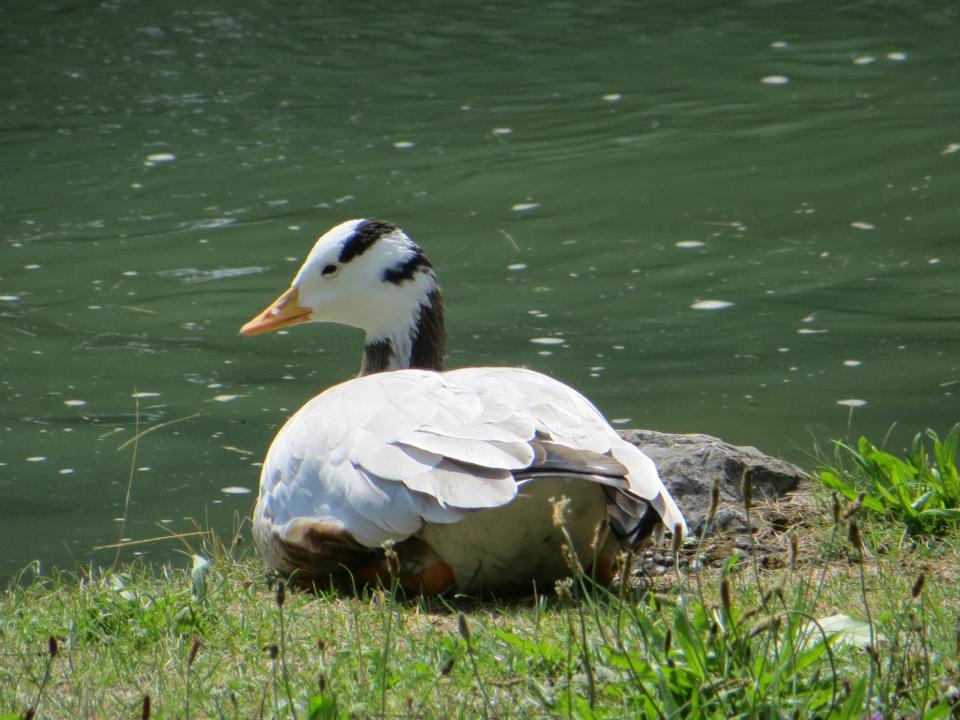
Figure 5 Bar-headed Goose (Anser indicus). Photo Credit: Canavan, 2013. Englisher Garden, Munich.
Researchers explored the possibility that the Qinghai variant of H5N1 had become intertwined with the long-range migration of aquatic birds.[38] It became imperative to find the virus transmission route, as scientists from diverse disciplines and countries traveled to Qinghai. Using GPS tracking devices, research teams gained a better understanding of the timing, pathways, stopover locations, and habitat use of migratory waterfowl originating from the Qinghai Lake breeding grounds. For bar-headed geese, the data revealed a previously unknown migratory pathway between Qinghai Lake and the Lhasa Valley of Tibet.[39] This is a region known for captive breeding farms of bar-headed geese and suggests that wild birds may play a key role in long distance spread of this virus.
The significance of the spread of H5N1 by migratory birds remains a topic of energetic debate and the role of wild birds in the perpetuation of disease is unclear. Knowledge about the ecology of the virus in wild birds is incomplete. The detection of viruses in migrating aquatic birds does not necessarily mean these viruses have been, or will be, successfully introduced into a new geographic area.[40] However, scientists know that ducks and geese are the primary disease reservoirs for the influenza viruses that infect chickens and other migratory birds.[41] In fact, the primordial source of all influenza viruses – avian and mammalian – is aquatic birds.[42] Chickens can transmit the avian flu virus directly to people, although the virus is not easily transmissible from human to human. Some analyses suggest that the avian virus spread initially due to the poultry trade, but once it moved out of Asia, it spread via migratory pathways to Europe.[43] The World Health Organization, the World Organization for Animal Health, and the Food and Agriculture Organization of the United Nations, the world’s leading medical, veterinary, and agricultural authorities, all implicate industrial poultry production (to varying degrees) as playing a role in the current bird flu crisis.[44] Whatever its mode of transmission, virologists concur that the spread of the virus via migratory birds is of ongoing concern for potential human flu pandemics.
Events at Qinghai sparked intensive interest among scientists who study viruses that jump the species barrier at the complex boundary of human, animal, and environmental domains.[45] Specifically, the bird flu crisis also raised questions about the natural environment at the Qinghai-Tibet Plateau. Researchers understand that the Qinghai Lake region is experiencing the most significant climate warming on the plateau.[46] Viral pathogens can be preserved in ice repositories, such as glaciers and lake ice. However, lake ice and permafrost do not receive much attention as a potential reservoir of microbes during surveillance activities for human diseases.[47] Monitoring of water chemistry, mountain topography, ultraviolet radiation, salinity, temperature, and precipitation will be keys to understanding the impacts of future climate change at high mountain lakes.[48] At Qinghai Lake, all these factors are undergoing change to some extent.
Scientists do not yet fully understand the links between climate change, biodiversity, pathogen mutation and disease spread. According to experts in ecology and evolutionary biology, a warming climate can accelerate pathogen replication and increase animal host susceptibility to infections.[49] A report commissioned by the United Nations Environmental Program claims that avian influenza will spread more quickly in damaged ecosystems.[50] Paul Epstein, a Harvard physician who helped alert scientists to the dangers of climate warming on health, noted that the “volatility of infectious diseases may be one of the earliest biological expressions of climate instability.”[51] Avian viruses have become more difficult to control because of changes in land use, intensive agriculture, and climate change.[52] Although effects of climate change are not easy to quantify, humankind may be underestimating the biological response to warming.
There is one fact, however, that may illuminate why the timing of avian flu outbreaks among wild and domestic birds coincided with the construction of the QTR. With over one hundred thousand workers temporarily living in rugged high-altitude conditions to work on the QTR, the Chinese government had to shelter and feed them. Based on published science as well as personal communications with scientists, it appears that wild bar-headed geese were raised in the Lhasa Valley as high-protein food for the QTR workers.[53] Some researchers argue that captive breeding of bar-headed geese, including attempts to interbreed them with domestic geese, represents a plausible route for the evolution of the avian virus to a more dangerous and deadly form.[54] This may indeed be the Pandora’s Box of the Qinghai-Tibet Plateau, opening a novel pathway for the spread of avian flu. One must also consider that multiple factors are at play – permafrost environment, climate warming, and poultry practices – contributing to the new bird flu crises originating at Qinghai.
Broader Impacts
The Qinghai-Tibet Plateau is the one constant among mutable threads of technology, environment, disease, culture, and geopolitics. The QTR provides a contemporary metaphor for a post-industrial world where nature, culture, and technology interact in increasingly complex ways.[55] As depicted in Machine in the Garden, a locomotive bursts onto the scene almost from nowhere, forever spoiling a pastoral ideal.[56] Despite mounting socio-economic and geopolitical pressures to fulfill state plans to develop China’s western regions, the QTR may not hold up to shifting permafrost despite remarkable technological advances.[57] Although it is surely a milestone of geotechnical achievement, the active permafrost layer beneath the QTR is thawing faster than expected.
From a natural history perspective, winged migration evokes a sense of human connection to the web of nature. The emergence of new variants of bird flu requires a lens of analysis that not only integrates the details of tracking viruses but also the interplay of environmental, social, and geopolitical factors. The genetic markers of these viruses provide a means of historical truth-telling. Although diverse research conducted at Qinghai is well-documented, historical precedents and ecological contexts have not been assessed.[58] Rapid changes at Qinghai challenge us to comprehend the scale of human exploitation in the natural world and to envision its unintended consequences.
Barbara Canavan holds a Ph.D. in the History of Science and Medicine from Oregon State University.
[1] Paul Theroux, Riding the Iron Rooster: By Train through China (New York: Ivy Books, 1989).
[2] Jung-sung Hsu, The Qinghai-Tibet Railway’s Impact on Tibet (Mongolian and Tibetan Affairs Commission, September 19, 2005).
[3] Erling Hoh, “Railway to the Top of the World,” New Internationalist, August 1, 2005.
[4] Abraham Lustgarten, China’s Great Train: Beijing’s Drive West and the Campaign to Remake Tibet (New York: Times Books, 2008), 52.
[5] Hoh, “Railway to the Top of the World.”
[6] Lustgarten, China’s Great Train, 233.
[7] E. Eckholm, “Drought Creates New Chinese Desert: Chinese Farmers See a New Desert Erode Their Way of Life,” New York Times, July 30, 2000; Charles Darwin may have coined the phrase “high as a horse’s belly” in Works of Charles Darwin: Journal of Researches into the Natural History and Geology of the Countries Visited during the Voyage of H.M.S. Beagle Round the World (D. Appleton, 1915).
[8] David Suzuki, “Wild China: The Tibetan Plateau,” The Nature of Things (Canadian Broadcasting Company, June 29, 2008).
[9] Huakun Zhou et al., “Alpine Grassland Degradation and Its Control in the Source Region of the Yangtze and Yellow Rivers, China,” Grassland Science 51, no. 3 (September 2005): 191–203.
[10] H. Xin, “China’s Environmental Challenges: A Green Fervor Sweeps the Qinghai-Tibetan Plateau,” Science 321, no. 5889 (August 2008): 633–35.
[11] Annual Report 2013, U.S. Congressional-Executive Commission on China (Washington D.C.: One Hundred Thirteenth Congress, October 10, 2013), 38.
[12] Huai Chen et al., “The Impacts of Climate Change and Human Activities on Biogeochemical Cycles on the Qinghai-Tibetan Plateau,” Global Change Biology 19, no. 10 (2013): 2940–2955.
[13] Xiaodong Liu and Baode Chen, “Climatic Warming in the Tibetan Plateau during Recent Decades,” International Journal of Climatology 20, no. 14 (November 30, 2000): 1729–42.
[14] Lin Huang et al., “Changing Inland Lakes Responding to Climate Warming in Northeastern Tibetan Plateau,” Climatic Change 109, no. 3–4 (December 2011): 479–502.
[15] B. Xu et al., “Black Soot and the Survival of Tibetan Glaciers,” Proceedings of the National Academy of Sciences 106, no. 52 (December 2009): 22114–18.
[16] TF Stocker et al., eds., Climate Change 2013: The Physical Science Basis. Contribution of Working Group I to the Fifth Assessment Report of the Intergovernmental Panel on Climate Change (New York: Cambridge Univ Pr, 2013), 92.
[17] Xin Li et al., “Cryospheric Change in China,” Global and Planetary Change 62, no. 3–4 (June 2008): 210–18.
[18] Yinghong Qin and Bo Zheng, “The Qinghai–Tibet Railway: A Landmark Project and Its Subsequent Environmental Challenges,” Environment, Development and Sustainability 12, no. 5 (January 2010): 859–73.
[19] T Zhang et al., “The Qinghai–Tibet Railroad: A Milestone Project and Its Environmental Impact,” Cold Regions Science and Technology 53, no. 3 (August 2008): 229–40.
[20] Han-hu Mu et al., Comparative Analysis of Cooling Effect of Crushed Rock Embankment along the Qinghai-Tibet Railway, S1 (Lanzhou, China: Cold and Arid Environmental and Engineering Research Institute, Chinese Academy of Sciences, 2010).
[21] Lustgarten, China’s Great Train, 173.
[22] Ibid., 180–81.
[23] National Geographic – Extreme Railway: Qinghai Tibet Railway [Video], 2014.
[24] Lustgarten, China’s Great Train, 102, 111.
[25] Tianyi Wu, “The Qinghai–Tibetan Plateau: How High Do Tibetans Live?,” High Altitude Medicine & Biology 2, no. 4 (December 2001): 489-499.
[26] X. Yi et al., “Archaeology Augments Tibet’s Genetic History–Response,” Science 329, no. 5998 (September 2010): 1467–68.
[27] X. Yi et al., “Sequencing of 50 Human Exomes Reveals Adaptation to High Altitude,” Science 329, no. 5987 (July 2010): 75–78.
[28] C. M. Beall, “From the Cover: Higher offspring survival among Tibetan women with high oxygen saturation genotypes residing at 4,000 m,” Proceedings of the National Academy of Sciences 101, no. 39 (September 2004): 14300-14304.
[29] C. M. Beall, “Colloquium Papers: Two Routes to Functional Adaptation: Tibetan and Andean High-Altitude Natives,” Proceedings of the National Academy of Sciences 104, no. suppl_1 (May 2007): 8655.
[30] Colleen Glyde Julian, Megan J. Wilson, and Lorna G. Moore, “Evolutionary Adaptation to High Altitude: A View from in Utero,” American Journal of Human Biology 21, no. 5 (September 2009): 614–22.
[31] Kerry Dumbaugh, Tibet: Problems, Prospects, and U.S. Policy (Washington D.C.: Congressional Research Service, April 10, 2008).
[32] “Politics Travel the China-Tibet Railway,” Marketplace World (American Public Media, June 3, 2008).
[33] X Xiao et al., “Remote Sensing, Ecological Variables, and Wild Bird Migration Related to Outbreaks of Highly Pathogenic H5N1 Avian Influenza,” J. Wildl Dis, no. 1 (January 2007): 40–47.
[34] J Liu et al., “Highly Pathogenic H5N1 Influenza Virus Infection in Migratory Birds,” Science (New York, N.Y.) 309, no. 5738 (August 19, 2005): 1206.
[35] L. Jiao, “In China’s Backcountry, Tracking Lethal Bird Flu,” Science 330, no. 6002 (October 2010): 313.
[36] Yongdong Li et al., “Persistent Circulation of Highly Pathogenic Influenza H5N1 Virus in Lake Qinghai Area of China,” Avian Diseases 54, no. 2 (June 2010): 821–29.
[37] Y. Kawaoka, Homeland Virology – 2/2/2014, This Week in Virology.
[38] H. Chen et al., “Establishment of Multiple Sublineages of H5N1 Influenza Virus in Asia: Implications for Pandemic Control,” Proceedings of the National Academy of Sciences 103, no. 8 (February 10, 2006): 2845–50.
[39] Diann J Prosser et al., “Wild Bird Migration across the Qinghai-Tibetan Plateau: A Transmission Route for Highly Pathogenic H5N1,” PloS One 6, no. 3 (2011): e17622.
[40] Boyce et al., “Avian Influenza Viruses in Wild Birds”; D. J. Hulse-Post et al., “Role of Domestic Ducks in the Propagation and Biological Evolution of Highly Pathogenic H5N1 Influenza Viruses in Asia,” Proceedings of the National Academy of Sciences of the United States of America 102, no. 30 (July 26, 2005): 10682–10687.
[41] Y Guan et al., “A Model to Control the Epidemic of H5N1 Influenza at the Source,” BMC Infectious Diseases 7 (2007): 132.
[42] R G Webster, “Influenza Virus: Transmission Between Species and Relevance to Emergence of the Next Human Pandemic,” in Viral Zoonoses and Food of Animal Origin, ed. Oskar-Rüger Kaaden, Claus-Peter Czerny, and Werner Eichhorn (Springer Vienna, 1997), 105–113.
[43] Peter Daszak, “Can We Predict Future Trends in Disease Emergence?” in Microbial Evolution and Co-Adaptation: A Tribute to the Life and Scientific Legacies of Joshua Lederberg: Workshop Summary, Forum on Microbial Threats (Washington D.C.: National Academies Press, 2009).
[44] Robert Hepworth, Avian Influenza and Wild Birds, International Scientific Task Force on Avian Influenza (Bonn, Germany: UNEP/CMS, 2006); Michael Greger, Bird Flu: A Virus of Our Own Hatching (New York: Lantern Books, 2006).
[45] Lonnie J King et al., “Executive Summary of the AVMA One Health Initiative Task Force Report,” Journal of the American Veterinary Medical Association 233, no. 2 (July 15, 2008): 259–261.
[46] Zhao et al., “Changes of Climate and Seasonally Frozen Ground over the Past 30 Years in Qinghai–Xizang (Tibetan) Plateau, China.”
[47] Scott O Rogers, William T Starmer, and John D Castello, “Recycling of Pathogenic Microbes through Survival in Ice,” Medical Hypotheses 63, no. 5 (2004): 773–777.
[48] Hailiang Dong et al., “Impacts of Environmental Change and Human Activity on Microbial Ecosystems on the Tibetan Plateau, NW China,” GSA Today, June 2010, 4–10.
[49] C. D. Harvell, “Climate Warming and Disease Risks for Terrestrial and Marine Biota,” Science 296, no. 5576 (June 2002): 2158–62; Anthony J McMichael, Rosalie E Woodruff, and Simon Hales, “Climate Change and Human Health: Present and Future Risks,” The Lancet 367, no. 9513 (March 2006): 859–69.
[50] International Institute for Sustainable Development, Avian Influenza & Wild Birds Bulletin, Scientific Seminar on Avian Influenza, the Environment and Migratory birds (Nairobi, Kenya, April 14, 2006).
[51] Paul R. Epstein, “Climate Change and Infectious Disease: Stormy Weather Ahead?,” Epidemiology 13, no. 4 (July 2002): 374.
[52] Christian Sandrock, “Editorial,” Comparative Immunology, Microbiology and Infectious Diseases 32, no. 4 (July 2009): 253–54; Nathan D. Wolfe, Claire Panosian Dunavan, and Jared Diamond, “Origins of Major Human Infectious Diseases,” Nature 447, no. 7142 (May 17, 2007): 279–83.
[53] Declan Butler, “Blogger Reveals China’s Migratory Goose Farms near Site of Flu Outbreak,” Nature 441, no. 7091 (May 18, 2006): 263. Personal communication with R. Webster, June 9, 2011.
[54] Scott H Newman et al., “Eco-Virological Approach for Assessing the Role of Wild Birds in the Spread of Avian Influenza H5N1 along the Central Asian Flyway,” PloS One 7, no. 2 (2012): e30636.
[55] Begoña Simal, “The Junkyard in the Jungle: Transnational, Transnatural Nature in Karen Tei Yamashita’s,” Journal of Transnational American Studies 2, no. 1 (March 30, 2010): 1.
[56] Leo Marx, The Machine in the Garden: Technology and the Pastoral Ideal in America. (New York: Oxford University Press, 1964).
[57] Chinese Academy of Sciences, “Thawing Soil May Endanger Qinghai-Tibet Railway,” February 27, 2006.
[58] The author’s dissertation, Opening Pandora’s Box at the Roof of the World, examines the history of avian influenza and the Qinghai case study in depth.
